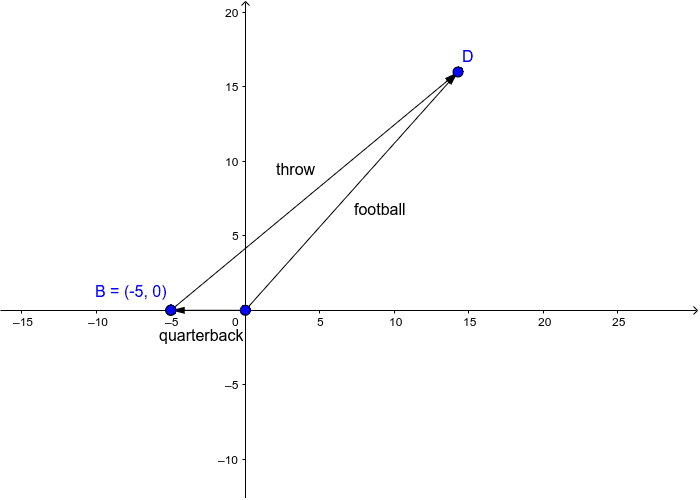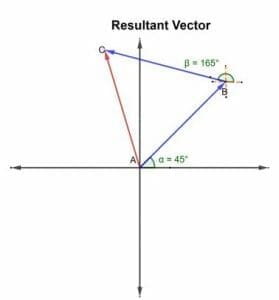How To Find Resultant Velocity And Direction
Learn how to find the magnitudes and direction of a resultant vector. Magnitude of the resultant velocity vector of the fish is Direction of the resultant velocity vector of the fish is.

Resultant Of Two Velocity Vectors Resultant Of Concurrent Force System Youtube
A motorboat is racing towards the north at 25kmh and the water current in that region is 10kmhr in the direction of 60 degrees east of the south.

How to find resultant velocity and direction. The resultant velocity in this case is 294 meters per secondJun 25 2018. For example if an object falls for 3 seconds multiply 3 by 98 meters per second squared which is the acceleration from gravity. The direction of the resultant velocity of the surfer arctan1060 946 Therefore The direction of the resultant velocity vector of the.
If you sketch this you will have a vector addition build a parallelogram of The boats speed vector and the water flows speed vector. The resultant velocity in this case is 294 meters per second. What is the resultant velocity.
Then break down each velocity into x and y components. From these final x and y components calculate the magnitude and direction of the resultant velocity. You can use eqn1 to write the velocity for a velocity of 235 km h in a direction 350 south of east and direction 255 north of east with a velocity of 249 kmh and then find the resultant velocity.
Im taking all online courses so I cant ask a teacher. For example if an object falls for 3 seconds multiply 3 by 98 meters per second squared which is the acceleration from gravity. Find the resultant velocity of the boat.
Find the magnitude direction and position of the resultant if the forces in the above problem are. The direction is calculated by finding the angle theta between the resultant velocity and the horizontal axis theta arctan yx where x is the magnitude of the x component and y is the magnitude of the y component. How To Calculate Resultant Velocity.
The velocity is as actually a vector with a direction. In both cases the direction of vectors take if one vector which in angular velocity and take another vector which in linear velocity in that cases first perform rotational motion and another perform linear motion so resultant vector have no perfect direction. The students will find the direction and magnitude of a resultant v.
About Press Copyright Contact us Creators Advertise Developers Terms Privacy Policy Safety How YouTube. I hope you know how to compute unit vector. While was an infinitesimal velocity in units of c it does not follow that the result of repeated transformations is proportional to the resultant velocity in the final transformed coordinates.
To find the resultant displacement in a physics problem apply the Pythagorean formula to the distance equation and use trigonometry to find the direction of movement. Multiply the acceleration by the time the object is being accelerated. The first part is quite easy and we get 218 approx as the magnitude of the resultant.
The formula Ive been told to use is tan VyVx but every time I put it in my calculator my answer is no where close to the actual answer. Substitute 30 ms for and 50 ms for. I took geometry last year but forgot a lot of stuff so if Im being dumb please tell me.
The Resultant velocity for two velocity components is known from kinematics flow while considering the velocity components u and v in the relation between stream function and velocity potential function and is represented as V sqrtu2 v2 or resultant_velocity sqrtVelocity component at u2 Velocity component at v2. Updated on May 29 2021. For example take north as 10 direction and draw an arrow in the correct length speed.
The students will find the direction. In this tutorial the students will learn how to find the resultant force of two vectors. The expression for resultant velocity vector is Here are the x y components of velocity and are the unit vectors representing positive x and y axis.
Multiply the acceleration by the time the object is being accelerated. The directions of the vectors you can extract from the given direction. We have step-by-step solutions for your textbooks written by Bartleby experts.
How do you find the direction of resultant velocity. Let me know if you dont know. Finding resultant and direction of resultant.
To calculate the resultant velocity first you must break up each individual velocity into its magnitude and direction vector. How do you calculate resultant velocity of two velocities in opposite directions. However from the equation z z cosh x 0 sinh we identify the resultant velocity as.
Textbook solution for Geometry Student Edition 1st Edition McGraw-Hill Chapter 87 Problem 7CYU. Next add together all of the x components and add together all of the y components.

Net Force Ranking Tasks Concept Builder Provides Learners An Opportunity To Use The Concept Of Net Force And Newton S Seco Physics Projects Body Diagram Force

Component Addition Concept Builder Challenges Learners To Apply Vector Principles And Mathematics In Order To Determine The M Concept How To Apply Mathematics

Resultant Speed Direction Two Forces Geogebra

Math Principles Resultant Of Forces And Components Force Physics Components

Relative Velocity Example 1 River Crossing Still Water River Example

Pin By Vanessa Owen On Fizik Dan Sains Gcse Physics Physics Lessons Physics

How To Find The Resultant Of Two Vectors Youtube

Resultant Velocity An Overview Sciencedirect Topics
Resultant As Magnitude And Direction Ck 12 Foundation

Lesson 1 Vector Addition Numerical

Resultant Force Time Graph Link To Speed Time Graph Learn Physics Physics Classroom Physics Notes

Determine The Magnitude And Direction Of The Resultant Force Youtube

Calculating Resultant Vector Using Rectangular Components

Newton S Laws S4 Physics Revision

Find The Magnitude And Direction Of The Resultant Of Two Vectors A And B In The Terms Of Their M Youtube
Physics Magnitude Of Resultant Vectors

Vector Diagram Resultant Velocity Concept Youtube

Finding Resultant Force From 2 Forces At 0 To 90 Degree Physics And Mathematics 90 Degrees Physics


Post a Comment for "How To Find Resultant Velocity And Direction"